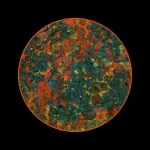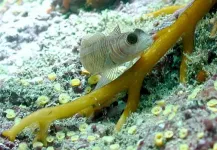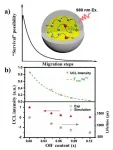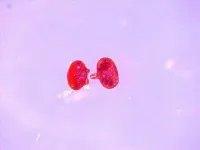New methods proposed to characterize polymer lamellar crystals
2021-05-27
(Press-News.org) Different from small molecules, polymer will fold into lamellar crystals during crystallization and further assemble into lamellar stacks.
Synchrotron Small-Angle X-Ray Scattering (SAXS) is an important tool to characterize such nanoscale structure and understand polymer crystallization. However, its scattering mechanism in semi-crystalline polymers is not completely elucidated yet.
Recently, a research group led by Prof. TIAN Xingyou from Institute of Solid State Physics, Hefei Institutes of Physical Science (HFIPS), proposed a complete set of new methods to characterize polymer lamellar crystals using SAXS.
"We've been working on this novel models for four years, from theory to application" said LI Xiangyang from HFIPS.
In 2019, the researchers first found that the existence of evanescent wave-induced scattering in transmission SAXS was possible. Moreover, the evanescent wave-induced scattering was much stronger than the scattering induced directly by incident X-ray, and the scattering of interfacial electrons within was the main origin of SAXS signal.
Then they started to try the approaches to obtain lamellar thickness, long period and lateral size. "Based on new SAXS image, we isolated the evanescent wave-induced scattering from the real scattering and reduced the influence of the scattering of bulk electrons, form factor and Porod scattering, obtaining the information on lamellar thickness and long period," said LI.
It was assumed that some residual crystals existed in the structured melt, whose lateral size is larger than critical nucleation size. However, it is hard to be testified due to the difficulty in characterization. With the new methodologies, the researchers characterized residual crystals, demonstrating previous conjecture.
This work is supported by the National Natural Science Foundation of China.
INFORMATION:
[Attachments] See images for this press release:
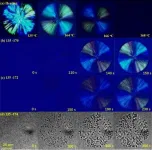
ELSE PRESS RELEASES FROM THIS DATE:
2021-05-27
Epithelial ovarian cancer (EOC) is the most common lethal gynaecological cancer. Ovarian cancer is usually treated with platinum-based chemotherapy; however, a significant number of patients are resistant to such treatments and relapse soon afterwards. To improve their survival, there is a need to first identify which patients may be platinum-resistant, so that newer treatments may be administered early.
Now, researchers from the Cancer Science Institute of Singapore (CSI Singapore) at the National University of Singapore (NUS), have discovered a way to predict which patients are resistant to platinum chemotherapy. The study, co-led by CSI Singapore Principal ...
2021-05-27
Current best practices for encouraging more female students to pursue degrees in economics may actually have the opposite effect and worsen gender disparities in the field, a recent study from Oregon State University found.
The study examined whether mass emails telling introductory economic students about promising career and earning opportunities helped increase female participation in higher-level economics courses. But instead, these emails appealed more to male students, increasing male enrollment and widening the existing gender gap. There was no change in the probability of female students majoring in economics.
Researchers say this demonstrates a need for more personalized, deliberate interventions.
"There ...
2021-05-27
Using renewable energy to replace fossil energy is now considered the best solution for greenhouse gas emission and air pollution problems. As a result, the demand for new and better energy storage technology is strong.
As part of the effort to improve this technology, a group led by Prof. ZHANG Suojiang from the Institute of Process Engineering (IPE) of the Chinese Academy of Sciences (CAS) recently found that ionophobic electrodes can boost energy storage performance.
Their study was published in the Journal of Materials Chemistry A on May 8.
Electric Double-Layer Capacitors (EDLCs) with ionic liquids (ILs)--as a new type of energy storage device--can fill the gap between the power density of batteries and the ...
2021-05-27
Human-driven global change is challenging the scientific community to understand how marine species might adapt to predicted environmental conditions in the near-future (e.g. hypoxia, ocean warming, and ocean acidification). The effects of the uptake of anthropogenic atmospheric CO2 by oceans affects (i.e. ocean acidification) propagate across the biological hierarchy, from changes in the building blocks of life at nano-scales to organism, physiology and behaviour through ecosystem processes and their properties.
To survive in a reduced pH environment, marine organisms have to adjust their physiology which, at the molecular level, is achieved by modifying the expression ...
2021-05-27
The great application prospect in biology, medicine, optogenetics, photovoltaics and sustainability has enabled lanthanide ions-doped upconversion nanoparticles to attract widespread attention which derives mainly from their superior anti-Stokes spectroscopic property. However, the relatively low upconversion efficiency remains a major bottleneck on their way of actual applications. Internal OH- impurity is known as one of the main detrimental factors affecting the upconversion efficiency of nanomaterials. Different from surface/ligand related emission quenching which can be effectively diminished by, e.g., core/shell structure, internal OH- is easy to be introduced during synthesis but difficult to be quantified and controlled.
In a new paper published in Light Science ...
2021-05-27
PHILADELPHIA--Antibodies aren't the only immune cells needed to fight off COVID-19 -- T cells are equally important and can step up to do the job when antibodies are depleted, suggests a new Penn Medicine study of blood cancer patients with COVID-19 published in Nature Medicine. The researchers found that blood cancer patients with COVID-19 who had higher CD8 T cells, many of whom had depleted antibodies from cancer treatments, were more than three times likelier to survive than patients with lower levels of CD8 T cells.
"It's clear T cells are critical in terms of the early infection and to help control the virus, but we also showed that they can compensate for B cell and antibody responses, which blood cancer patients are likely missing because of the drugs," said co-senior author Alexander ...
2021-05-27
PULLMAN, Wash. -- A new fungus strain could provide a chemical-free method for eradicating mites that kill honey bees, according to a study published this month in Scientific Reports.
A team led by Washington State University entomologists bred a strain of Metarhizium, a common fungus found in soils around the world, to work as a control agent against varroa mites. Unlike other strains of Metarhizium, the one created by the WSU research team can survive in the warm environments common in honey bee hives, which typically have a temperature of around 35 Celsius (or 95 F).
"We've known that metarhizium could kill mites, but it was expensive and didn't last long because the fungi died in the hive heat," said Steve Sheppard, professor in WSU's Department of Entomology and corresponding ...
2021-05-27
A research group at the University of Córdoba evaluated the commercial mixture formulated in a laboratory and the tank-based mixture of two herbicides to determine which method is more effective in terms of weed control and environmental impact.
In 2017 the company Nufarm Europe proposed to the Higher Technical School of Agricultural and Forestry Engineering (ETSIAM) at the UCO a study of the results of two products having a significant agronomic impact: the herbicides glyphosate and 2,4-D (synthetic auxin). After three years of research, they concluded that the commercial mix produced in the company's laboratories is more effective than manual mixes produced in tanks.
To do this, they used in vivo techniques (tests with greenhouse ...
2021-05-27
MAY 26, 2021 -- Researchers from UTSA, the University of Central Florida (UCF), the Air Force Research Laboratory (AFRL) and SRI International have developed a new method that improves how artificial intelligence learns to see.
Led by Sumit Jha, professor in the Department of Computer Science at UTSA, the team has changed the conventional approach employed in explaining machine learning decisions that relies on a single injection of noise into the input layer of a neural network.
The team shows that adding noise--also known as pixilation--along multiple layers of a network provides a more robust representation of an image that's recognized by the AI ...
2021-05-27
The Menetries' tiger moth (Arctia menetriesii) is one of the rarest and most poorly studied Palaearctic moth species. Even though its adult individuals are large and brightly coloured, they are difficult to spot, because they aren't attracted to light, they're not active at night, and they fly reluctantly. Currently, the species only inhabits two countries - Finland and the Russian Federation, and is included in the Red Lists of both, as Data Deficient in the former and Vulnerable in the latter.
For 13 years, researcher Evgeny Koshkin of the Institute of Water and Ecology Problems of the Far ...
LAST 30 PRESS RELEASES:
[Press-News.org] New methods proposed to characterize polymer lamellar crystals

